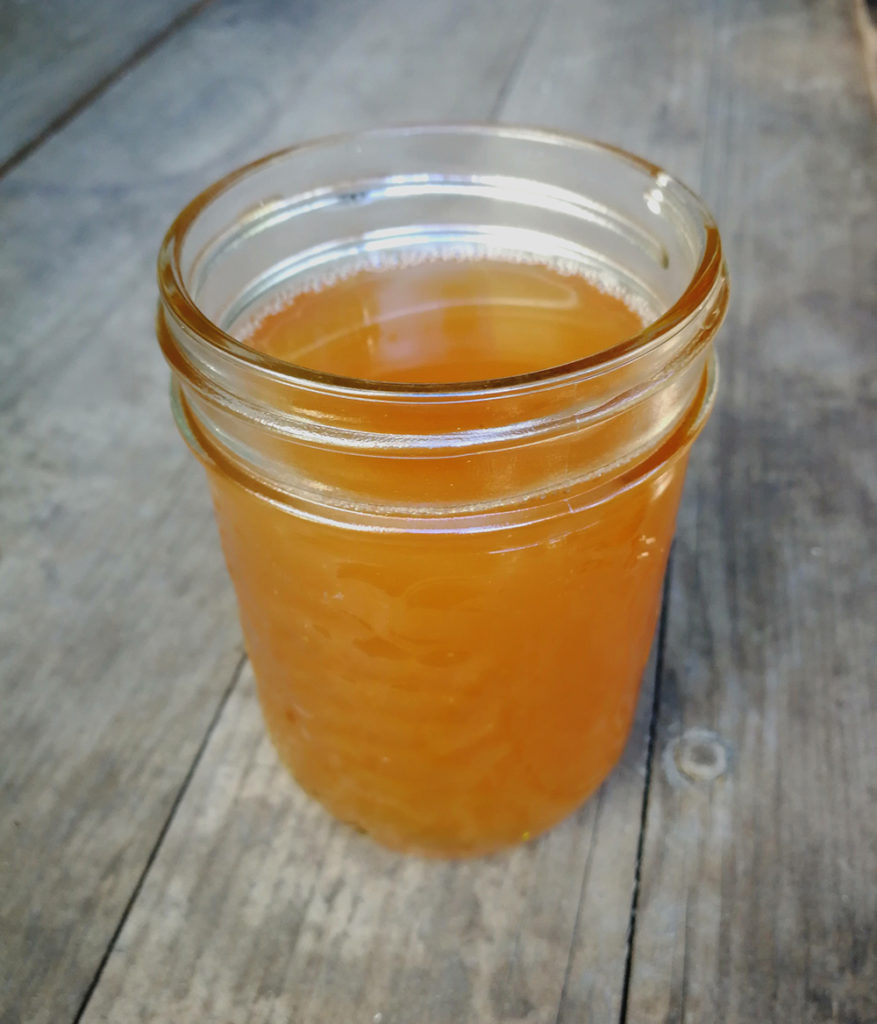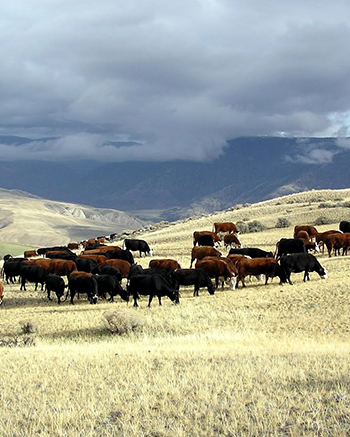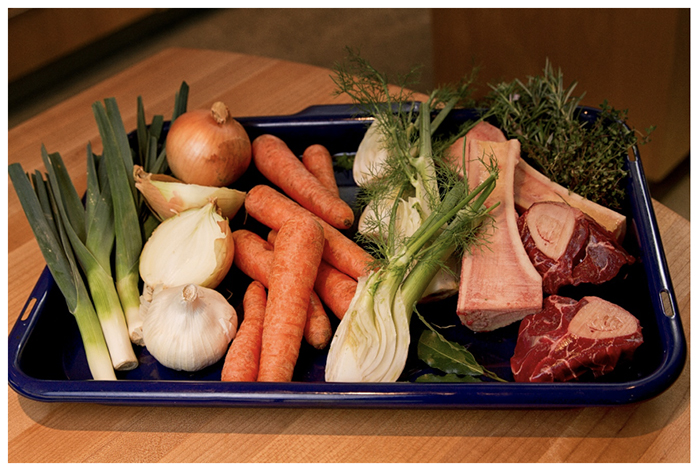In Season: Bone broth for optimal health

Starting to feel autumn’s chill creeping into your bones? Warm up and get healthy this season with bone broth, that age-old staple of traditional diets that is both nutrient-dense and deeply hydrating. The following nutritional info and recipes come from Andrea Potter, RHN, who teaches a wide range of whole foods cooking classes both privately and at the Vancouver campus of Canadian School of Natural Nutrition.

Bone Broth
by Andrea Potter, RHN
Our ancestors were thrifty; they knew how to utilize every single part of the animal. They were also wise; bone stocks provide dense nutrition which is easily digested, the perfect food for children, the elderly, the sick, and for those of us who just live on the real world, and who need good food to fuel and heal ourselves in our busy lives.
Nutrition and Therapeutic Benefits of Bone Broth
+ Gelatin (made of collagen) from joint bones like knuckles, back vertebrae and feet, is a digestive aid. The gelatin in bone stock is a hydrophilic colloid. It is one of the only cooked foods that attracts digestive enzymes by attracting and holding water, including digestive juices. This is also why bone broth is deeply hydrating.
+ Collagen in bone broths is powerful in building new connective tissue and skin. Therefore, it is especially helpful in healing from surgery, healing injuries, benefits athletes, pregnant people, growing children and even improves the suppleness of the skin and improves hair growth.
+ Bone broths contain the minerals of the bone, cartilage and marrow, as well as the nutrients from the vegetables and the benefits of the herbs that they are cooked with.
+ Bone marrow is around 96% fat and contains myeloid and lymphoid stem cells. Within the animal, these cells create red and white blood cells and build immunity. Valued as a prized food source in many traditional populations, bone marrow was thought to nourish children and pregnant women. More studies are underway with renewed interest in eating the ‘odd bits’ and what their nutritional benefits are.
Here’s what you will need:
A stock pot –a 2 quart (8 liter) dutch oven or heavy-bottomed pot is great. If you are interested in making a large quantity and freezing it, use a 20 liter pot. The larger the pot of course, the pricier they get. If your budget does not allow for a commercial heavy-bottomed stainless steel 20 liter stock pot, buy a big pot with a thinner bottom and a heat diffuser.
Roasting pan– the kind you put a turkey or chicken in is good. Any oven-proof vessel with sides is fine. Even a baking (cookie) sheet works.
Strainer – the idea is to get the chunks out, so a colander works. The finer the sieve or strainer, the clearer your stock will be. I have worked at restaurants who filtered bone broth through a coffee filter- three times for clarity. This may be excessive for the home cook, as there are no nutritional benefits to clearer bone broth. The usual kitchen stuff such as oven mitts or towels, chopping board and sharp knife, containers to strain the stock into…

Brown Stock Method for Beef, Lamb, or Venison
All recipes by Andrea Potter, RHN
Ingredients
- 5 lb bones of beef, veal, lamb, venison…
- 3 onions, large dice
- Optional: 1 leek, washed and large dice. Green part is ok.
- About 6 medium carrots, large dice
- Celery, 6 stocks
- 1 4-6 inch piece kombu seaweed
- 1 can tomato paste, or about 6 halves sun-dried tomatoes, or a couple of fresh tomatoes
- Thyme, rosemary, bay leaf and peppercorns
Directions
- It is best to have the butcher cut the bones from big animals. Otherwise you will be missing out on much of the flavour of the marrow within them. This also makes them easier to handle. Marrow bones have the most nutrition, but a few rib bones with meat still on them adds flavour too.
- Place the bones and veggies in a roasting pan and brown in the oven at about 375 F (190 C) or higher. This may take over an hour. Drizzling a little oil on them helps keep them from burning and sticking.
- Once they are brown, place them in a stock pot and more than cover the bones and veggies with cold water and add your spices, seaweed and herbs. Put on the heat and bring to a simmer. This will produce some scum. (The white-ish stuff that comes to the top.) Skim the scum with a ladle.
- Drain the fat from the roasting pan. ( This step is actually optional, and just for a clear stock. The fat always rises to the top when it cools, so if you are cooling it, just skip this step and add the fat to the pot).
- Those brown bits on the bottom are full of flavour. In fact, the French have a word for this. They call it ‘fond’, meaning foundation. De-glaze the pan using water, wine or vinegar. Add this to the stock pot or slow cooker.
- I like to cook my beef stock for 12-24 hours. I let it sit on the burner on very low overnight, covering it with a lid will ensure that it does not boil dry. (Don’t forget to crack a window in the house.)
- Strain the stock through a sieve or colander. Cool the stock by putting the bucket of stock into a sink full of ice OR by placing it by a cool window on a cooling rack. Once cooled, refrigerate. The fat will come to the top and harden. Keeping the fat undisturbed while cooling allows the stock to last much longer in the fridge or to freeze without freezer burn. (This keeps in the fridge for 5 days or so.)
- Freeze it in 1 liter containers for convenience. If you don’t have much room in the freezer, put the stock back into the pot and boil it down until it reaches a thick consistency. This is called demi glaze or demi glace. It is the base for all meat-based reduction sauces. You can add a few spoonful’s of this beef jelly to a soup made with water, and it’s basically the same as using regular-strength stock.
Chicken Stock
Ingredients
- 1 chicken carcass from roasting or a couple of packages of bones.
- 2 onions
- 2 carrots
- 1 leek (cleaned well), optional
- 3 stocks celery
- 1 bulb fennel(opt)
- 1 bulb garlic, cut in half width-wise
- A couple inch piece of kombu seaweed
- Either ¼ cup egg-shell vinegar (see side note) OR 1 lemon, cut in half
- thyme, bay leaf and black peppercorns
Directions
- Chop up all of the veggies big and chunky. In a roasting pan, drizzle the vegetables with oil and ‘toss’ them up to coat.
- Add the chicken carcass/bones to the veggies.
- Roast in the oven at 350F for 45 minutes or until it smells great and the veggies are a bit golden in colour.
- Then transfer them into a big pot and put your herbs and spices in. Add water until vegetables are submersed and water is about halfway up the pot. (About 3.5 liters)
- Then simmer for 4-8 hours and strain.
- Let liquid cool, then put into freezable 1 liter container and label with the date.
- See, that was easy!
Looking for bones from grass fed, free range animals for your broth? Vancouver Farmers Markets has a wide variety of ranchers and producers on our roster. Aurora View Farms, Central Park Farms, Empire Valley Beef, Outwest Ranches and Windy Creek Farm are great sources for beef, and Goldwing, K & M Farms, and Rockweld Farms are all good choices for chicken and poultry. More info on vendors and products on our product search page.
Don’t want to make your own bone broth? Pick some up from Shorba Broth Bar at the markets – click here for a list of their upcoming dates.




